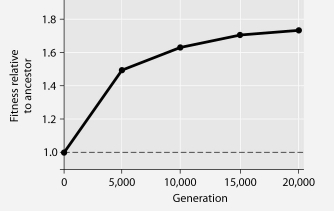The following questions refer to Figure 27.1.
In this eight-year experiment, 12 populations of E. coli, each begun from a single cell, were grown in low-glucose conditions for 20,000 generations. Each culture was introduced to fresh growth medium every 24 hours. Occasionally, samples were removed from the populations, and their fitness in low-glucose conditions was tested against that of members sampled from the ancestral (common ancestor) E. coli population.

Figure 27.1
-Which of the following, if it occurs in the absence of any other type of adaptation listed here, is least reasonable in terms of promoting bacterial survival over evolutionary time in a low-glucose environment?
A) increased efficiency at transporting glucose into the cell from the environment
B) increased ability to survive on simple sugars, other than glucose
C) increased ability to synthesize glucose from amino acid precursors
D) increased reliance on glycolytic enzymes
E) increased sensitivity to, and ability to move toward, whatever glucose is present in its habitat
Correct Answer:
Verified
Q45: Use the information in the following paragraph
Q46: During which two times can the recipient
Q47: The following questions refer to Figure 27.1.
In
Q48: Use the information in the following paragraph
Q49: Consider the thermoacidophile, Sulfolobus acidocaldarius. Which of
Q51: Which question, arising from the results depicted
Q52: Figure 27.2 depicts changes to the amount
Q53: Use the information in the following paragraph
Q54: Use the information in the following paragraph
Q55: Figure 27.2 depicts changes to the amount
Unlock this Answer For Free Now!
View this answer and more for free by performing one of the following actions

Scan the QR code to install the App and get 2 free unlocks

Unlock quizzes for free by uploading documents